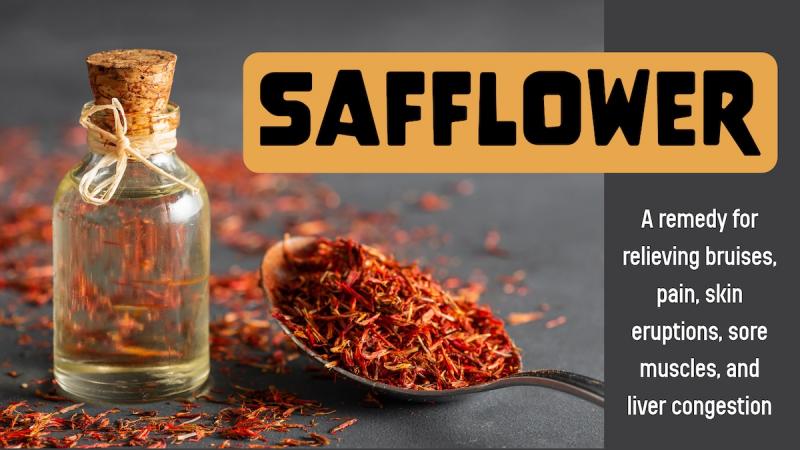
Safflower is a thistle-like plant in the Asteracea family that has been cultivated as a source of oil derived from its seeds. The seeds, like flaxseeds, can be eaten for their omega-3 fatty acids and there are two varieties of oil derived from the plant. The first is high in the linoleic acid (about 70-80 percent). This type of oil is unsuitable for cooking, but it is used as an alternative to linseed oil in paints.
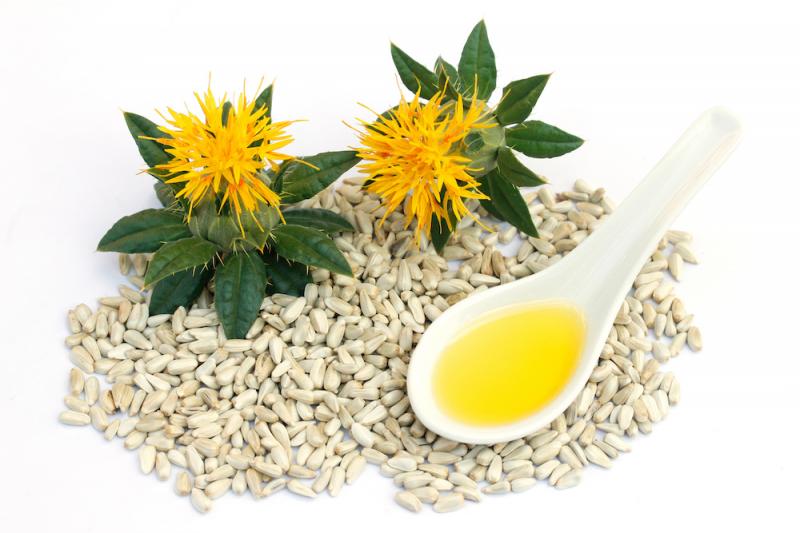 The second variety of oil is the kind of safflower oil you'll find in stores. It's used as a cooking oil and is high in the monounsaturated oleic acid, also found in avocado and olive oil. Oleic acid comprises almost 80% of this oil. It’s a popular cooking oil because it has a high smoke point (450 degrees), but is also high in omega-6 essential fatty acids, which most of us are getting too much of in our diets.
The second variety of oil is the kind of safflower oil you'll find in stores. It's used as a cooking oil and is high in the monounsaturated oleic acid, also found in avocado and olive oil. Oleic acid comprises almost 80% of this oil. It’s a popular cooking oil because it has a high smoke point (450 degrees), but is also high in omega-6 essential fatty acids, which most of us are getting too much of in our diets.
You can read more of my thoughts on the subject of fats and oils in the article on Understanding Fats. The Weston A. Price Foundation has some great material on fats and oils, under the title Know Your Fats if you want to research this topic further.
Safflower Herb
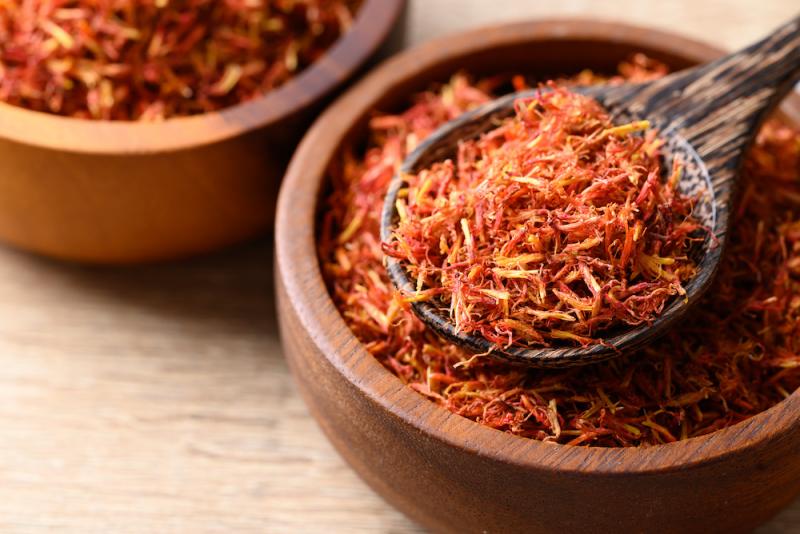 The flowers, or more specifically the petals, of safflower are a great medicinal herb. The petals are also used in cooking as a cheaper alternative to saffron and as a source of dye.
The flowers, or more specifically the petals, of safflower are a great medicinal herb. The petals are also used in cooking as a cheaper alternative to saffron and as a source of dye.
Safflower has an affinity for the blood. It works somewhat like arnica to move stagnant blood and lymph in bruises and swellings. But, it doesn't have the toxicity of arnica. It’s used in traditional Chinese medicine (TCM) to activate blood circulation and eliminate blood stasis. Smaller doses are used to stimulate circulation and nourish the blood, while larger doses are used to remove stagnant blood. It can be applied topically and/or used internally to relieve bruises or any condition that’s causing a bluish-purple cast to the skin.
Blood Purifier
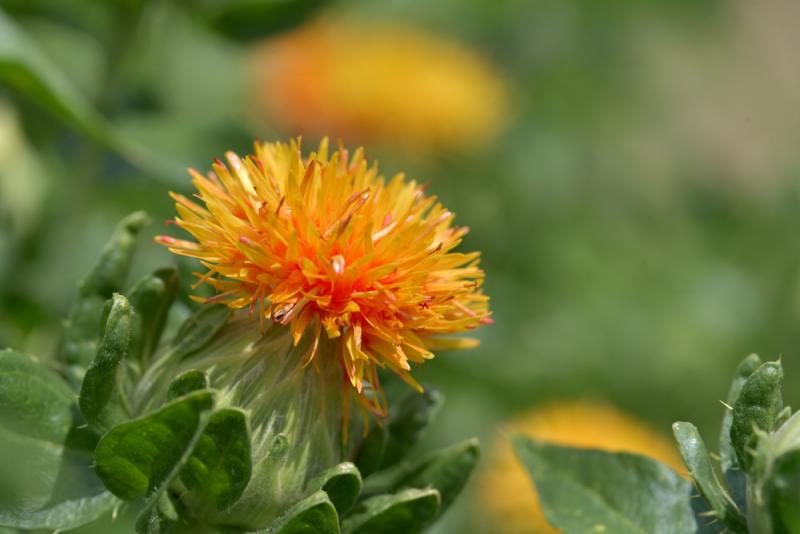 The idea of blood purifiers (also known as alteratives) is that they help to clean up the blood in morbid conditions, including skin eruptive diseases. Safflower has been used to help treat diseases like chicken pox, measles, and rashes. It helps move the blood to the surface to help the body clear out the disease. It's particularly indicated in these diseases when they are accompanied by a fever because moving blood toward the surface aids perspiration which helps break the fever.
The idea of blood purifiers (also known as alteratives) is that they help to clean up the blood in morbid conditions, including skin eruptive diseases. Safflower has been used to help treat diseases like chicken pox, measles, and rashes. It helps move the blood to the surface to help the body clear out the disease. It's particularly indicated in these diseases when they are accompanied by a fever because moving blood toward the surface aids perspiration which helps break the fever.
What’s nice about safflower is that it makes a rather mild-flavored tea. This makes it a good remedy for sick children who are too young to swallow capsules.
I remember one of the first times I used safflower was when our midwife recommended it to treat a case of jaundice. We gave the baby some unsweetened safflower tea and a little bit of activated charcoal mixed with water. Along with sitting next to the window to get some sunlight on the baby’s skin, this cleared the problem up.
As I understand it, the liver is particularly prone to congested circulation because a large part of its blood supply comes from the portal vein. This vein takes blood from the capillaries in the intestines and directs it to the liver where it moves into a second bed of capillaries. This allows the liver to filter the blood before it returns the general circulation. But, since this blood must pass through two sets of capillaries instead of one, if there is any sluggishness in the venous circulation the liver circulation is especially hit hard. So, I believe that safflower aids the liver by improving blood flow through it.
Safflower and Sore Muscles
Another major use I’ve made of safflower is for easing sore muscles after over-exertion. I’ve used it for this purpose on myself and others. I made a quart of safflower tea using about 2-3 teaspoons of the herb steeped for twenty to thirty minutes. You then drink the entire quart of tea over the course of a couple of hours. It also helps to apply capsicum and lobelia tinctures topically to the sore muscles and follow this up with an analgesic essential oil blend containing oils like camphor, menthol, eucalyptus, clove, and wintergreen.
If you tend to have low blood sugar and get sore muscles easily, you can drink the tea before exercise to prevent sore muscles. It also helps you exercise better by stimulating blood flow.
Other Uses for Safflower
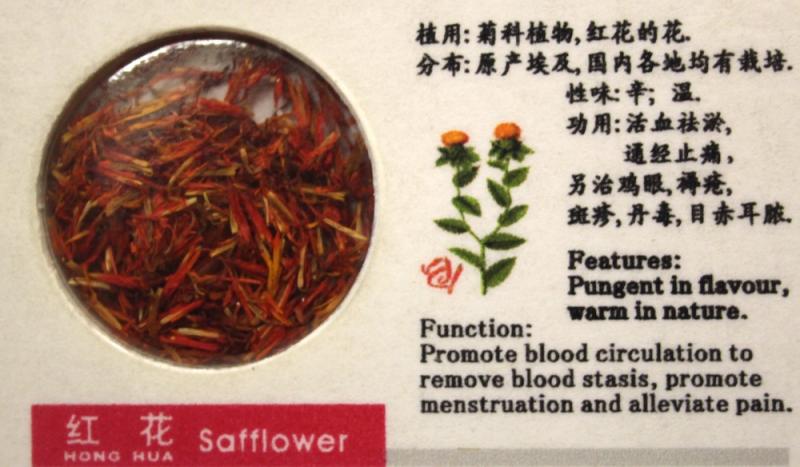 Safflower may be helpful for arthritis by improving circulation to the joints but needs to be combined with other herbs that promote healing of the joints. Matthew Wood reports it is helpful in Raynaud’s disease, along with yarrow and prickly ash.
Safflower may be helpful for arthritis by improving circulation to the joints but needs to be combined with other herbs that promote healing of the joints. Matthew Wood reports it is helpful in Raynaud’s disease, along with yarrow and prickly ash.
A major use of safflower in TCM is for gynecological problems. It’s used for menstrual pain involving pelvic congestion (swelling and pain in the lower abdomen). It would combine well with ginger and dong quai for this purpose. They also use it for amenorrhea (lack of periods), again in combination with other Chinese female tonic herbs.
It’s also used in TCM for abdominal pain, joint pain, and chest pain (angina). It would not be used alone for these purposes but in combination with other herbs appropriate to the situation. Furthermore, a primary indication that safflowers would be a good remedy would be a darkish, purplish tongue or dark purplish spots on the tongue or the skin, which indicate a lack of good blood flow (blood stasis).
This brings us to an important concept for every skilled herbalist to understand. You don’t just pick an herb based on a particular disease. You select remedies based on the overall situation. Safflower isn’t going to be helpful for liver problems, arthritis, menstrual problems, or any other condition unless there are signs that a lack of good blood flow is part of the picture. The herb doesn't treat a disease, it helps to correct the underlying problems that contributes to these issues.
Steven's Articles
-

-
The Health Benefits and Problems with Coffee
This popular caffeinated beverage can be beneficial…
October
-

-
Understanding Caffeine & Cellular Adaptation
Preserving the power of caffeine's buzz and the…
September
-

-
Horseradish
A pungent spice for aiding protein metabolism…
-

-
Banaba or Crepe Myrtle
A beautiful tree from Southeast Asia whose leaves…
August
-

-
Monkeyflowers
Flower essences to help see ourselves more clearly…
-

-
Mariposa Lilies
Strengthening the bond between mother and child…
-

-
The Noble Bay Leaf
A common kitchen herb for aiding digestion and…
-

-
Epimedium: Horny Goat Weed
A circulatory stimulant and kidney yang tonic…
July
-

-
The Medicinal and Nutritional Benefits of Apricots
A nutritious fruit and valuable medicinal seed for coughs
-

-
Dogwoods
Asian dogwood is used to stop excessive discharge,…
June
-

-
Neem: The Village Pharmacy
A popular Ayurvedic remedy for dental and immune…
-

-
Spilanthes: The Toothache Plant
A traditional remedy for teeth and gums, as well…
-

-
Forsythia
An anti-inflammatory, fever-reducing, and infection fighting herb
May
-

-
Buckwheat (Kashi)
A delicious, high protein, gluten-free, gut-healthy food
-

-
Leaky Gut Syndrome
Plugging the leaks on the underlying cause of…

